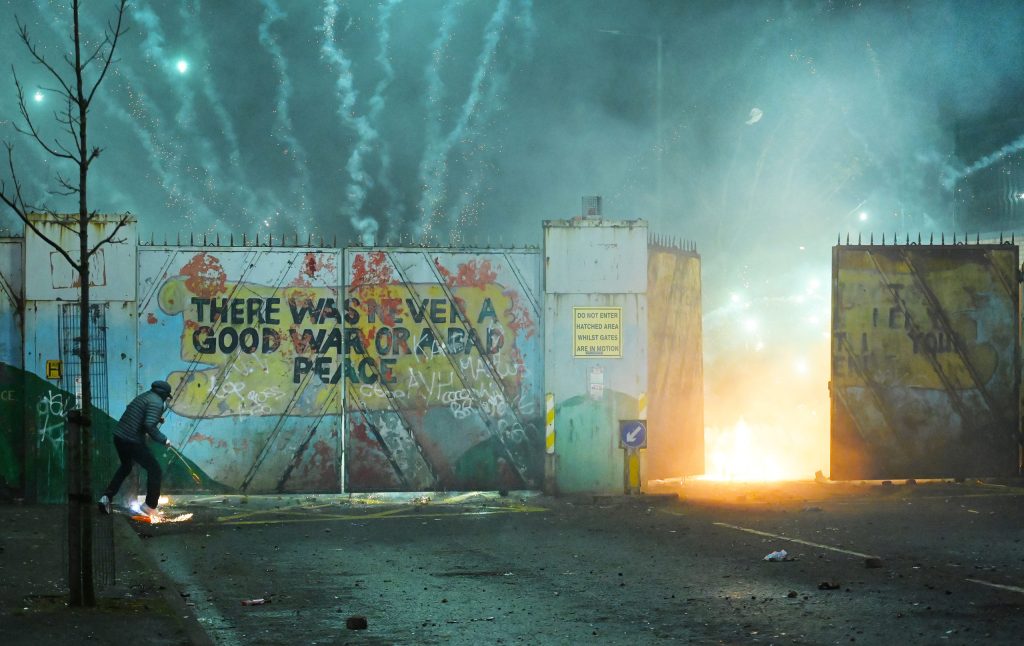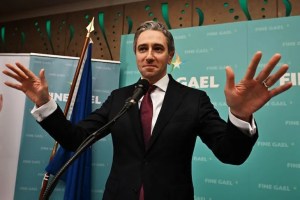On the 23rd anniversary of the signing of the Belfast Agreement, it’s safe to say celebrations here in Northern Ireland will be muted at best.
Over the past 10 days, hundreds of rioters wielding bricks, bottles, stones and petrol bombs in Belfast have injured more than 70 police officers, most notably in the west of the city, where working-class loyalists and republicans live cheek by jowl. In terrifying scenes, a bus driver narrowly escaped injury when his vehicle was petrol bombed and left to coast down a street.
The trigger for the violence was the decision by Northern Ireland’s public prosecution service not to bring charges against 24 Sinn Féin politicians who broke COVID restrictions at a funeral of an IRA leader, which 2,000 attended.
Inevitable accusations of ‘one rule for them’ ensued, with palpable anger from many who have been observing COVID restrictions for months. As a result, Arlene Foster, the first minister, called for Northern Ireland’s chief constable to resign, even refusing to speak to him for a time.
After two decades of relative peace, the vast majority of people in Northern Ireland enjoy a high quality of life, with the highest per capita public sector spend in the whole of the UK. But in a small number of hardline areas, physical structures still exist, quite simply, to prevent some Protestants and Catholics mixing. It is against this backdrop that violence has ensued. The most arresting image of the trouble this week was that of teenagers not even born when the Belfast Agreement was signed hurling petrol bombs towards a ‘peace wall’ gate emblazoned with the graffitied phrase: ‘there was never a good war or a bad peace’. As the peace wall caught fire, irony was extinguished.
So where are the parents? Some of the children are as young as 12. Footage shows at least some parents egging on their children, directing their activities and helping them escape police in riot gear.
And while the rioters’ actions can never be condoned, their anger must be understood. It stems from factors including a sense of abandonment over the Brexit sea border, which now means there are checks on some goods going between Northern Ireland and the rest of the UK. The result is the perceived erosion of their cultural identity; the Britishness they hold so dearly.
Straightforward criminality is a factor too. In 1998 many paramilitaries unsurprisingly did not go straight out and get proper jobs; racketeering, drug dealing and turf wars continue. Successful police drugs raids have also angered the gang masters, some of whom have been directing the violence of their younger acolytes. Significantly, last week a group of loyalist paramilitaries wrote to Boris Johnson to withdraw their support for the Belfast Agreement.
In the face of crisis, Northern Ireland has historically shown that talking can work. So more dialogue has occurred, this time with Northern Ireland secretary Brandon Lewis hosting political leaders at Stormont in a pattern that feels all too familiar (I write as a veteran of such talks). All in the room will agree with him. The problem is that their influence is limited with the rioters, who remain livid with the political class, and especially the DUP.
It takes a lot to unite a petrol bomb-wielding loyalist and a liberal, knitwear-sporting Unionist pottering around a garden center. But the way in which the sea border is manifesting itself has seen accusations from all shades of Unionism that the UK government has forgotten about Northern Ireland, abandoning it, some argue, to what amounts to an economically united Ireland.
Brexit got done, yes, but Northern Ireland got stitched up in the process, they believe. The DUP, having campaigned for Brexit, is in a tricky spot.
With Scotland increasingly in peril, the fear is that Northern Ireland could be the next domino. Mature Dublin politicians such as Jim O’Callaghan, who may end up as the next leader of Taoiseach Micheál Martin’s Fianna Fáil party, are unambiguously setting out their view of what a United Ireland would actually look like. Some in Northern Ireland are wondering, too, where they might end up fitting in.
In Westminster, Brandon Lewis has extended the grace period for checks across the Irish Sea, which will help, but a proper solution to the protocol must be found. Michael Gove has recruited the able special adviser Keelan Carr to assist him in saving the Union, but for understandable reasons Scotland is their primary focus. The return to the Cabinet Office of senior mandarin Sue Gray, who has been ably running Northern Ireland’s department of finance for the past three years, will help. Unlike the vast majority in Whitehall, she understands the nuances of Northern Ireland.
With Northern Ireland’s centenary just months away, a clear case for the Union appears increasingly difficult for some to articulate. It is not inconceivable that the island of Ireland will have both a Sinn Féin first minister in Belfast and taoiseach in Dublin by 2025, which feels to many Unionists like a slippery slope to a united Ireland. There is a clause in the Belfast Agreement compelling the secretary of state to call a referendum should sufficient evidence of a move to a unity present itself. Many worry that may soon prove difficult to resist.
This article was originally published on The Spectator’s UK website.


















